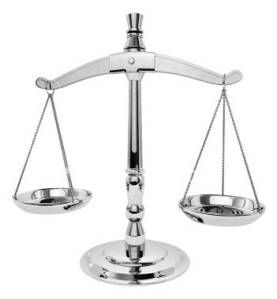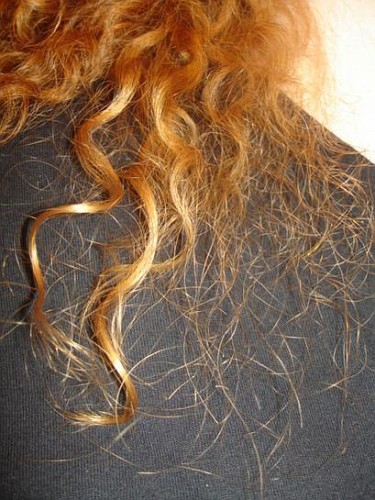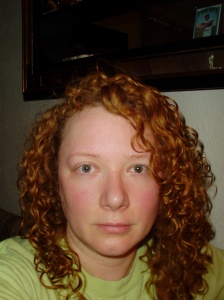 Anyone who has spent any time at all on hair message boards will eventually run across various thoughts about protein. Some love it, some hate it, others are confused by it.
Anyone who has spent any time at all on hair message boards will eventually run across various thoughts about protein. Some love it, some hate it, others are confused by it.
Having hair that is on the coarse side, I have a strong dislike for most proteins. When I started trying to change how I cared for my curls, I had a long process of having too much protein and too little moisture for my hair. I lost a lot of curl, my hair became quite brittle, and parts of it would just snap right off. After A LOT of trial and error, I found that to keep a proper moisture balance in my hair, I needed very little protein and fairly frequent moisture.
But, how do you know if you need protein or moisture? Well, there is already an excellent article about that. It gives great scenarios, and it teaches you how to test your own hair to see how you are on the moisture/protein balance spectrum.
Apart from the testing there, there are a couple of other things that I use to see if I need protein or moisture.
If I am having an unusual amount of frizz on my canopy (the outermost layer of hair) I usually hit it with moisture first because my hair type tends to lack moisture more often than it lacks protein. If that doesn’t help, then I may try an ACV rinse to help seal the cuticle. If I still don’t get good results, then I know I need some protein. This usually does the trick, and the canopy frizz will then be resolved. I use protein last only because I need less of it than others do.
If only my ends are crunchy, I look at it from many angles since this one can be more complicated. The ends are the oldest parts of your hair, so they can be the most moisture starved. But, they can also be the most porous, so they could also need more protein. Also, crunchy ends can just be from buildup from products and conditioners and such. Clarifying with a cleanser or shampoo of your choice should help.
The first thing I do with crunchy ends it to give them an extra hit of moisture by leaving a rich conditioner on my ends. I usually use my Aubrey Organics Honeysuckle Rose or Curl Junkie Curl Rehab for this.
If that doesn’t help, I may try protein.
If it persists, I use a gentle shampoo on the ends (since I don’t use daily shampoo) to get whatever buildup may be on there.
Some people also have problems with hard water, and that can give you crunchy ends that none of the treatments above will fix. For that, you need a chelating shampoo, which will contain EDTA in the ingredients list. If you get frequent hard water buildup on your hair, you may want to look into a shower filter for hard water.
Those of you with finer hair will usually need more protein than those with coarse hair. Coarse hair has its own protein already built in, so it needs less of it from products. Finer hair does not have as much protein built in, and it can benefit from the strengthening properties protein can give it. But, as with everything else, there are always exceptions, so the tests provided in the link above will help you to be more precise.
Also, weather can play a role. I need very little protein in the winter, but can take more of it in the summer.
Another common question is: “How do I know if my product has a protein?”
While the list of proteins can be lengthy, there are a few simple guidelines to help you find them
If an ingredient says protein, it’s a protein. I know it seems obvious, but people do ask. 🙂
If it says “amino acid” then it will act like protein on your hair. Amino acids are the building blocks of protein.
Just about any ingredient that has the word “hydrolyzed” before it will be a protein. Hydrolyzed itself does not mean protein, but hydrolyzation in conditioner world often means that a large protein has been broken down into a smaller one to make the protein more easily used by the hair. Hydrolyzed wheat, soy, and silk are common.
Plant extracts. Plants contain protein, and so do their extracts. This category is not as commonly problematic as hydrolyzed grains, but they still do bother some. One high protein treatment I have seen is essentially a long list of grass extracts!
Plant oils, when properly processed, should be protein free. Look at any nutrition label of any 100% oil. You’ll see that there is no protein. Some natural websites that sell wheat germ oil claim that wheat germ oil contains proteins. An article by the Curl Chemist addresses this.
Coconut oil. Although it does not contain protein, coconut oil has been shown to reduce protein loss in hair. For some, this acts just like having protein buildup on hair. Coconut milk contains actual protein.
Jojoba oil is technically a liquid wax and may contain small amounts of protein.
What does too much or too little protein look like?
When I had too much protein, my hair lost its curl and was dry and crunchy. Here’s a pic.

Too Much Protein
After getting rid of protein in my routine, the curl bounced back up.

Good protein/moisture balance
After some time of that, I lost some curl in my roots, and the curl was just droopy overall, like this.

Needing protein
I found that I was able to tolerate keratin protein, (hair is made of keratin) and it is still the only protein I can tolerate. My droopy curls perked back up after using it.

After a keratin treatment
So, having too much or too little protein can really change the curl pattern in your hair. Learning how your hair reacts to it can be a learning process, but it becomes more automatic with time. Keeping a proper protein/moisture balance is one of the most important issues in maintaing your curls.